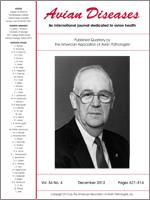Ornithobacterium rhinotracheale (ORT) is a gram-negative staining rod. In chickens and turkeys ORT causes a respiratory disease. Between 2009 and 2011 some 714 dry swabs taken from diseased turkeys, broilers, broiler breeders, layers, or from unknown origin were investigated by PCR for the presence of ORT. Swabs that tested positive numbered 197 out of 481 from turkeys (41.0%), 10 out of 144 from broilers or broiler breeders (6.9%), 17 out of 28 from layers (60.7%), and 26 out of 61 from unknown origin (42.6%). The results of three swabs from turkeys were suspect. Furthermore, 310 isolates from turkeys and 62 isolates from unknown origin were typed using an agar gel precipitation (AGP) test. Of the isolates from turkeys, 56.1% belonged to serotype A and 20.6% to serotype E. The prevalence of other isolates was below 10%. Serotypes D, F, and K were not detected. Eleven isolates were not typable with reference sera against serotypes A–L. The three serotypes most often found in the isolates from unknown origin were A (35.5%), B (19.4%), and C (12.9%). The prevalence of other isolates was below 10%. Serotypes F and K were not detected. Seven isolates were not typable with reference sera A–L. Cross-reactions, especially of serotype A isolates with serotypes I, H, and J, were common. Additionally, the partial 16S ribosomal RNA (rRNA) and the complete Or01 genes of reference strains A–H and of nine field isolates were cloned and sequenced. Identity scores of 16S rRNA fragments were between 98% and 100%. Identities of the Or01 sequences were between 94% and 100%. Phylogenetic trees of both genes showed similarities. However, there was no apparent correlation between reference strains and isolates belonging to one serotype, so sequencing of 16S rRNA or of the Or01 gene does not seem to be a suitable method to replace the AGP for serotyping. Further investigations are necessary to clarify the cross-reactions between different serotypes and their real role in the pathogenicity and in consideration of vaccine production.
BioOne.org will be down briefly for maintenance on 17 December 2024 between 18:00-22:00 Pacific Time US. We apologize for any inconvenience.
How to translate text using browser tools
1 December 2012
Detection and Typing of Ornithobacterium rhinotracheale from German Poultry Flocks
Sureerat Numee,
Rüdiger Hauck,
Hafez M. Hafez
ACCESS THE FULL ARTICLE

Avian Diseases
Vol. 56 • No. 4
December 2012
Vol. 56 • No. 4
December 2012




